My Southern Crispy Fried Oysters Recipe is for you if you love oysters and want to make five-star, restaurant-quality, golden brown fried oysters at home.
No need to be a trained chef—my easy step-by-step fried oyster recipe and expert tips and tricks guarantee your success.
Don’t wait to savor the mouthwatering bliss of salty, silky oysters coated in a perfectly seasoned, crispy cornmeal crust. Check out my easy recipe today!
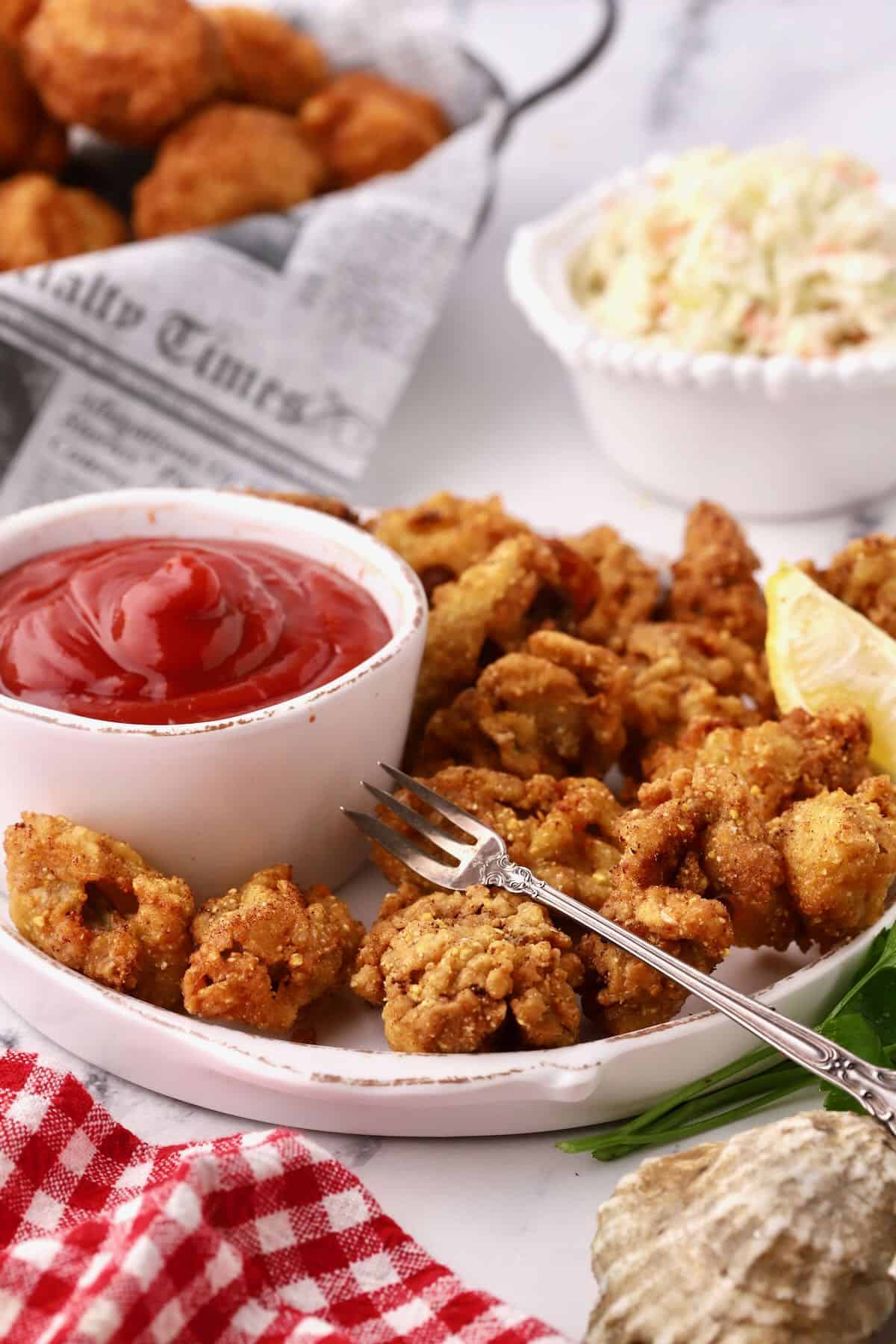
Join over 300,000 other oyster lovers and discover why this fried oyster recipe is one of my blog’s best and most popular dishes. With a rich combination of textures and flavors, every bite is pure cornmeal fried oyster bliss. Your taste buds will thank you, and your friends will beg for your secret recipe!
⭐ ⭐ ⭐⭐⭐ from Mark: “This is the best fried oyster recipe I have tried! Follow this simple recipe, and you will not be disappointed.”
Quick and easy to prepare, these versatile, breaded, deep-fried oysters are considered a true seafood delicacy.
Like my recipes for Oysters Rockefeller, Buffalo Shrimp, Fried Spanish Mackerel Nuggets, Chicken Egg Rolls, Cheese Quesadillas, and Fried Crab Claws, they can be served as a tasty appetizer or a delicious dinner entrée.
Fried oysters are also ideal for a quick weeknight dinner, a beach fish fry, Fish Friday, or a Sunday seafood supper and are a must-have ingredient on a fried seafood platter.
Jump to:
- 🥘 Why This is the Best Recipe for Fried Oysters:
- 📋 Fried Oysters Ingredients
- ♨️ How to Make Fried Oyster Recipe
- 🍲 What do fried oysters taste like?
- 💭 Top tip:
- 📖 Fried Oyster Recipe Variations:
- 🍽 Where to buy fresh oysters:
- 🍽Fried Oyster Serving Suggestions
- How to Store and Reheat Fried Oysters
- 💬 Recipe FAQs:
- 💭 More expert tips and tricks:
- Other Fried Seafood Recipes
- 📋 Recipe:
🥘 Why This is the Best Recipe for Fried Oysters:
- One of the most popular recipes on my blog, this fried oyster recipe only takes minutes to cook, has stood the test of time, and readers have given it a perfect five-star rating.
- I’ve included simple instructions and tips designed to minimize any potential mess from frying, including grease splatter or a fried seafood smell.
- Did I mention it was easy? Simply soak the tasty bivalves in buttermilk, dredge them in seasoned cornmeal breading mix, and then fry in hot oil for two to three minutes. That’s it!
📋 Fried Oysters Ingredients
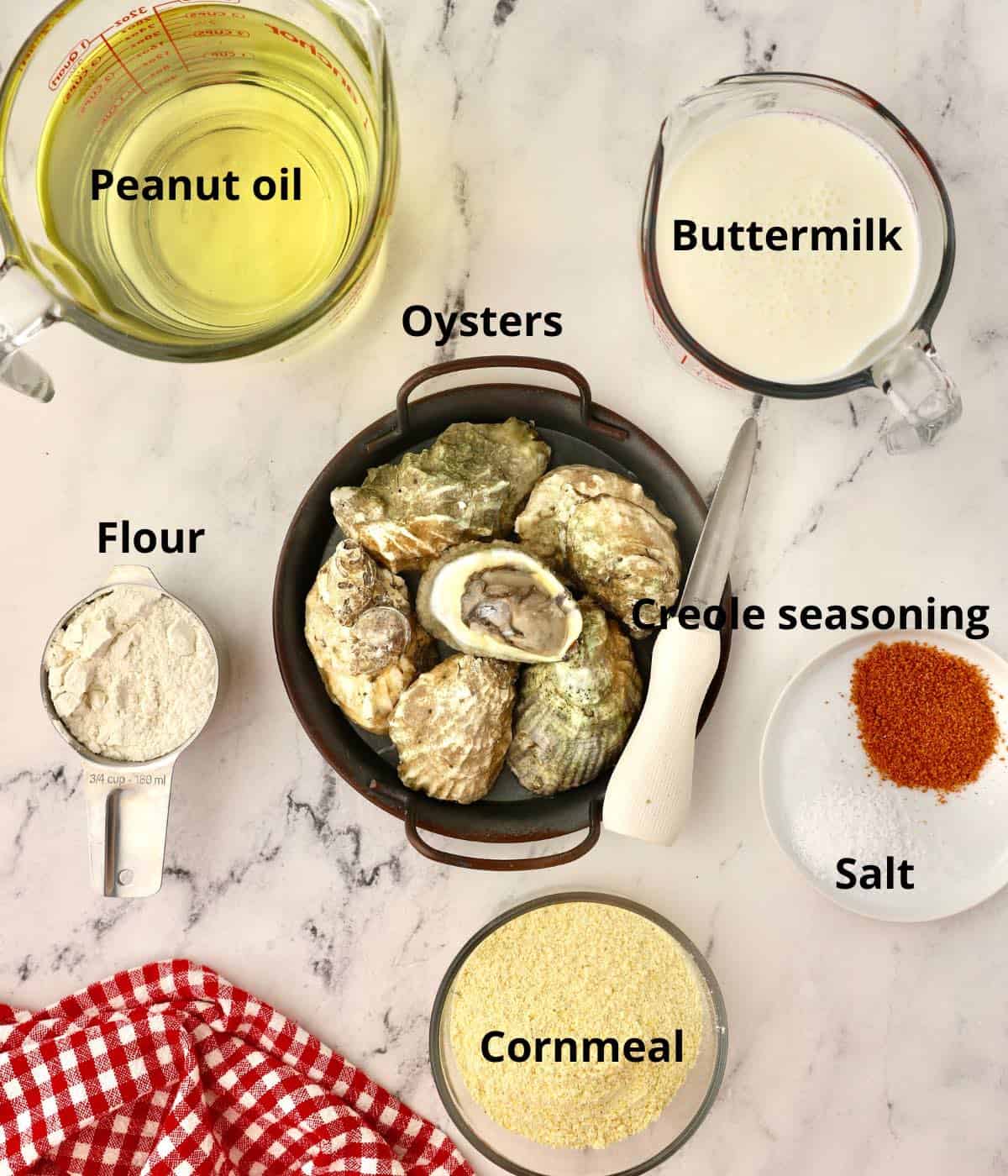
- Freshly shucked raw oysters – with their mild fresh sea breeze aroma and natural salinity, are the star of this dish. With modern refrigeration and aquaculture methods, most are farmed, harvested, and available at seafood or grocery stores year-round, shucked or unshucked.
- Do I need to rinse oysters? I generally do not rinse them. However, depending on the shucker’s skill, they may contain bits of shell or other debris after being shucked. So, if you are worried about that, you should rinse them in cold water and drain them before making this recipe.
- Buttermilk – is an essential ingredient in this recipe. With its pleasant and characteristic tang and rich taste, buttermilk is the perfect consistency to coat the oysters and help the cornmeal breading stick.
- Cornmeal – made from dried field corn, is another essential ingredient in the breading that adds a distinctive flavor and texture. Cornmeal gives the crispy oysters a delicious extra-crunchy crust and helps them develop a lovely golden brown color. You can use either yellow or white fine cornmeal.
- All-purpose flour – combines with cornmeal to create the breading.
- Creole seasoning, along with kosher salt – seasons the cornmeal breading, provides a touch of spice and enhances all of the flavors. Cajun seasoning may be substituted for Creole. Creole seasoning contains more herbs, while Cajun has a blend of ground peppers, so it has a bit more kick.
- Peanut oil – is the oil of choice for frying in the South, and for good reason; it has a neutral taste, and you can cook foods at high temperatures without smoking. If you are looking for a good substitute, both vegetable and canola oil work, too.
(A complete list of ingredients and measurements is listed in the recipe below.)
♨️ How to Make Fried Oyster Recipe
- Pour the shucked oysters into a colander or strainer and let them drain. I don’t usually rinse mine, but if you prefer, rinse them with cold water to wash off debris or shell fragments and let drain.
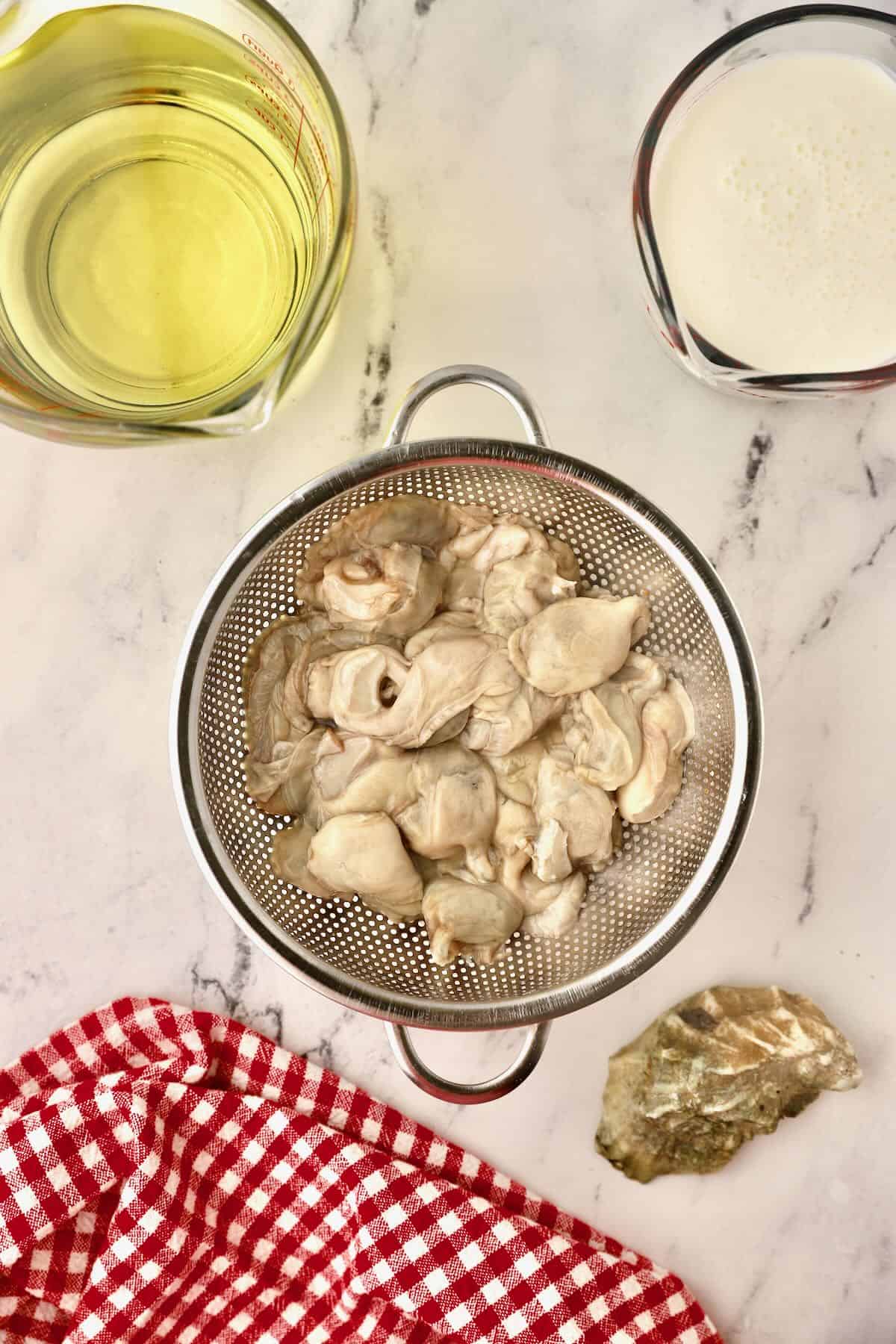
- Pour the buttermilk into a medium-sized bowl and add the drained oysters. Let them soak for 15 to 20 minutes.
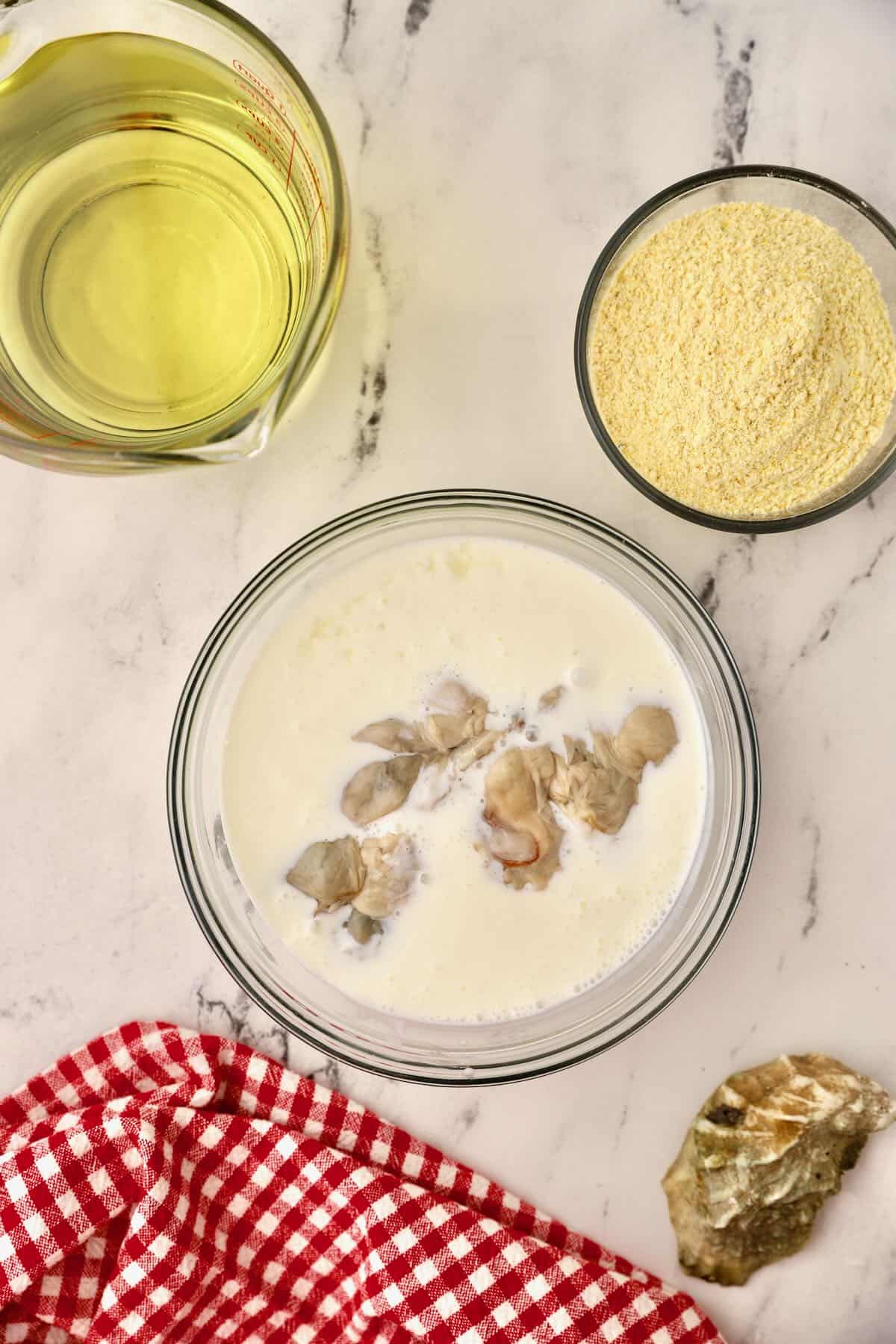
- Combine flour, cornmeal, Creole seasoning, and salt in a shallow bowl or pie plate and whisk to combine.
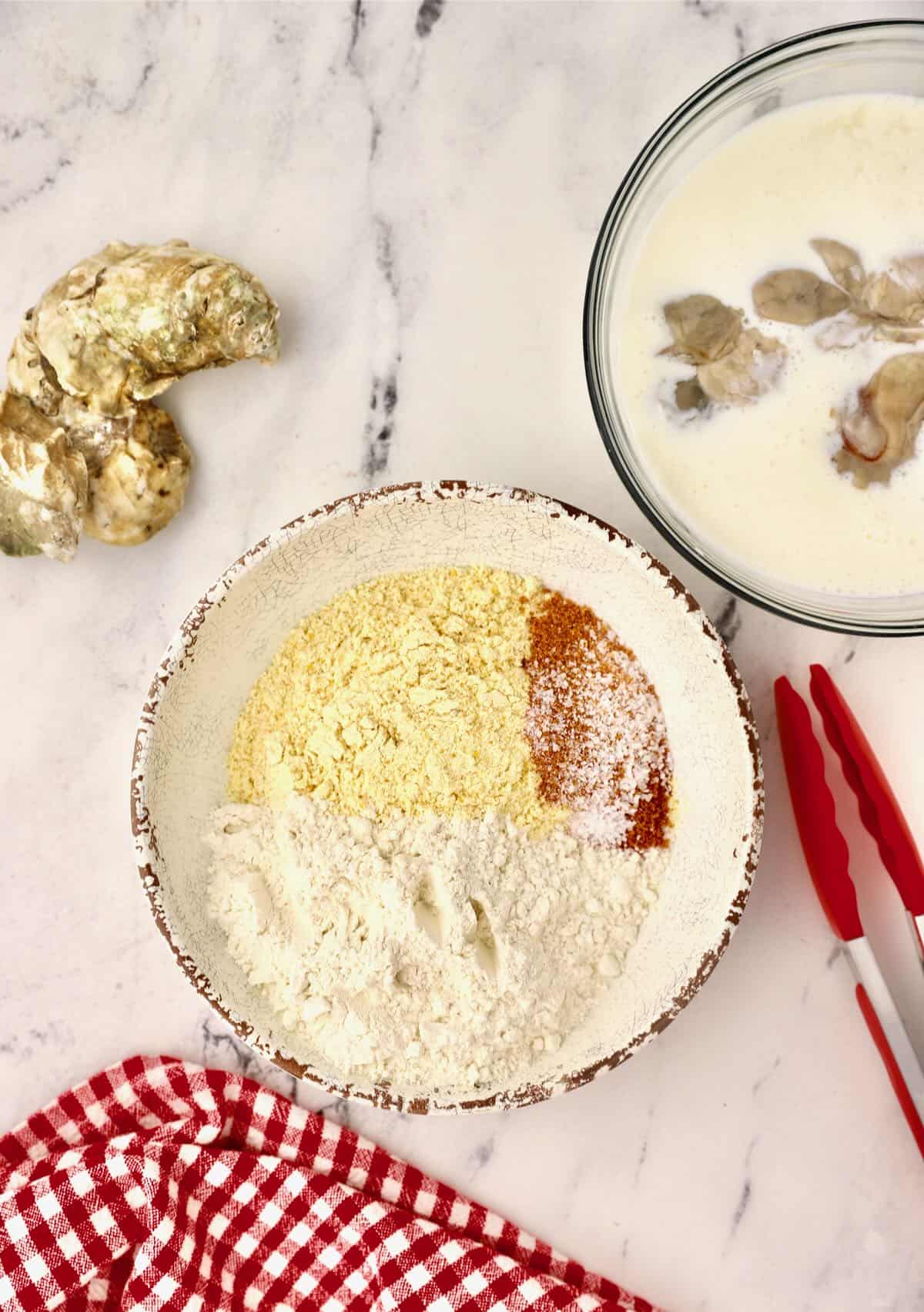
- Remove the oysters from the buttermilk mixture, one at a time and dredge them in the cornmeal mixture. Toss gently and make sure they are well coated, then shake off any excess breading.
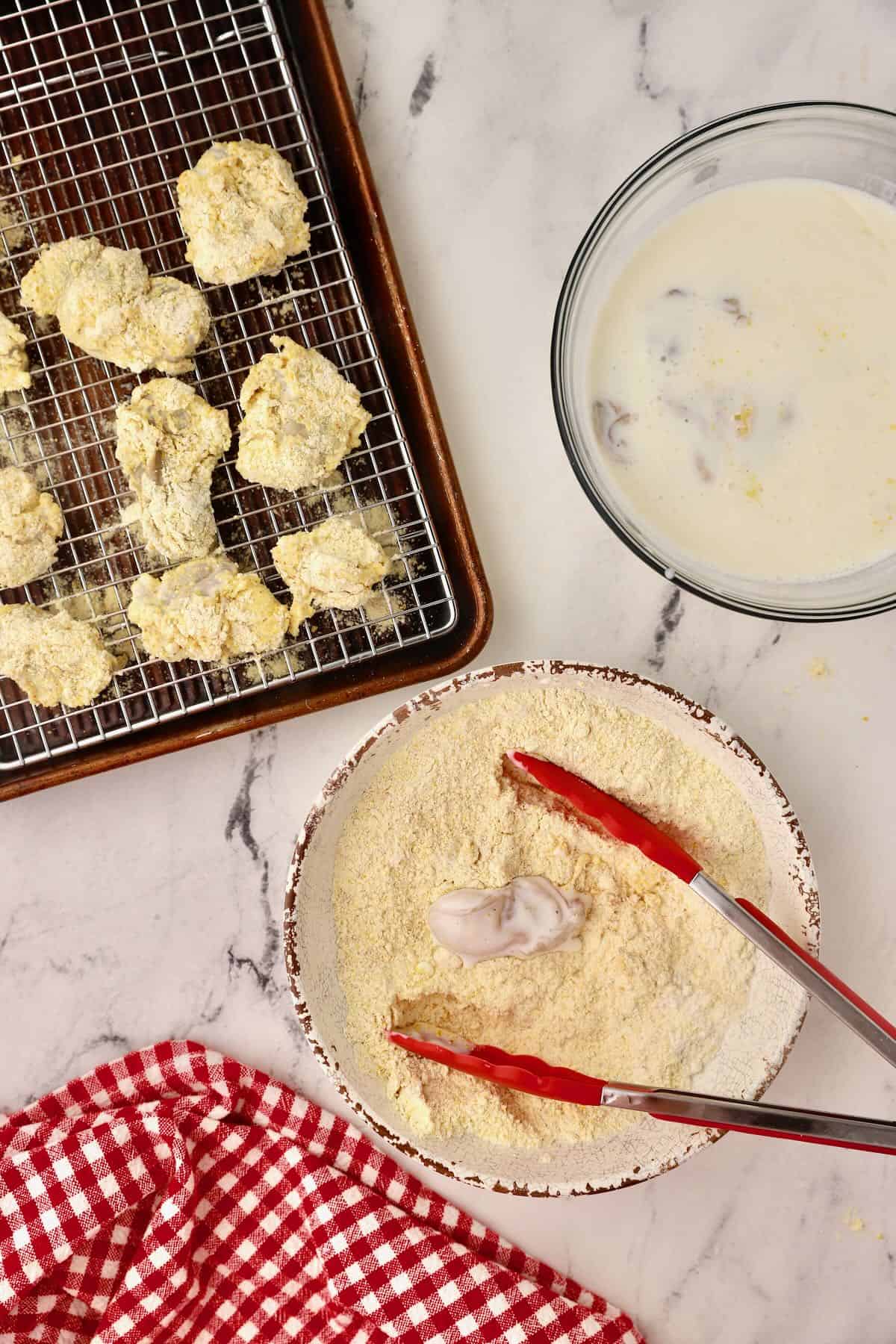
- Place the coated oysters on a metal cooling rack until they are all coated. Let them sit for a few minutes. This step helps to fuse the breading and buttermilk and keeps the breading from falling off when they are fried.
- Place a large heavy-duty stockpot, Dutch oven, or cast iron skillet with high sides over medium-high heat. Add one to two inches of oil and heat oil.
- Use a candy or deep-fry thermometer to test the oil temperature. When it reaches 350°F, carefully add the oysters one at a time. Depending on the size of your pan, it works best to fry in small batches. Only cook six to eight at a time. You do not want to crowd them. (Maintain a consistent heat of 350°F by increasing or decreasing the heat under the pan.)
- Let the oysters fry for about two to three minutes. Stir occasionally or until the breading is light golden brown and the meat is opaque with the edges slightly curled.
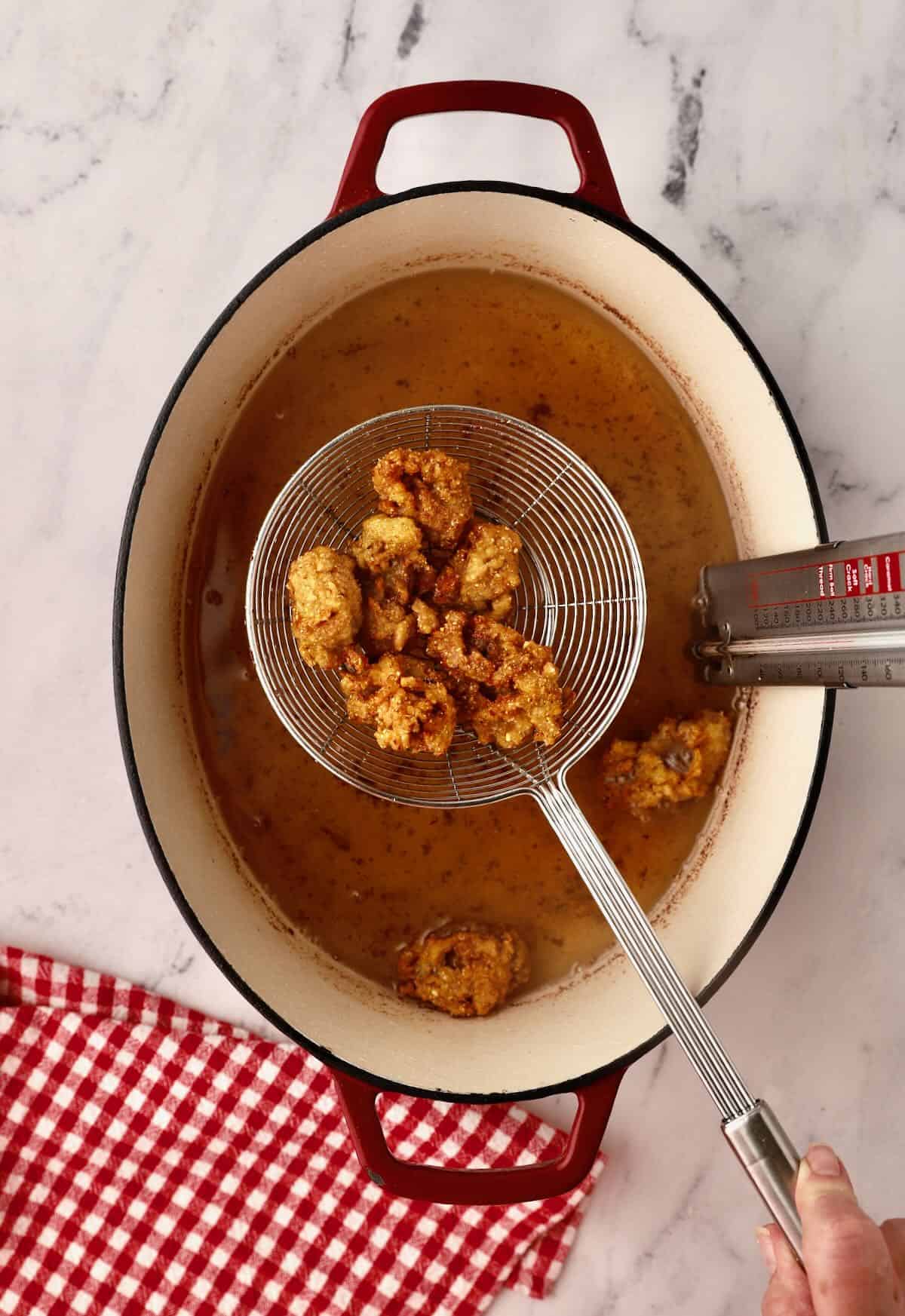
- Use a wire kitchen spider or slotted spoon to remove them from the oil. Place them on a paper towel or wire cooling rack to drain. Repeat until all of the oysters are fried, and serve immediately.
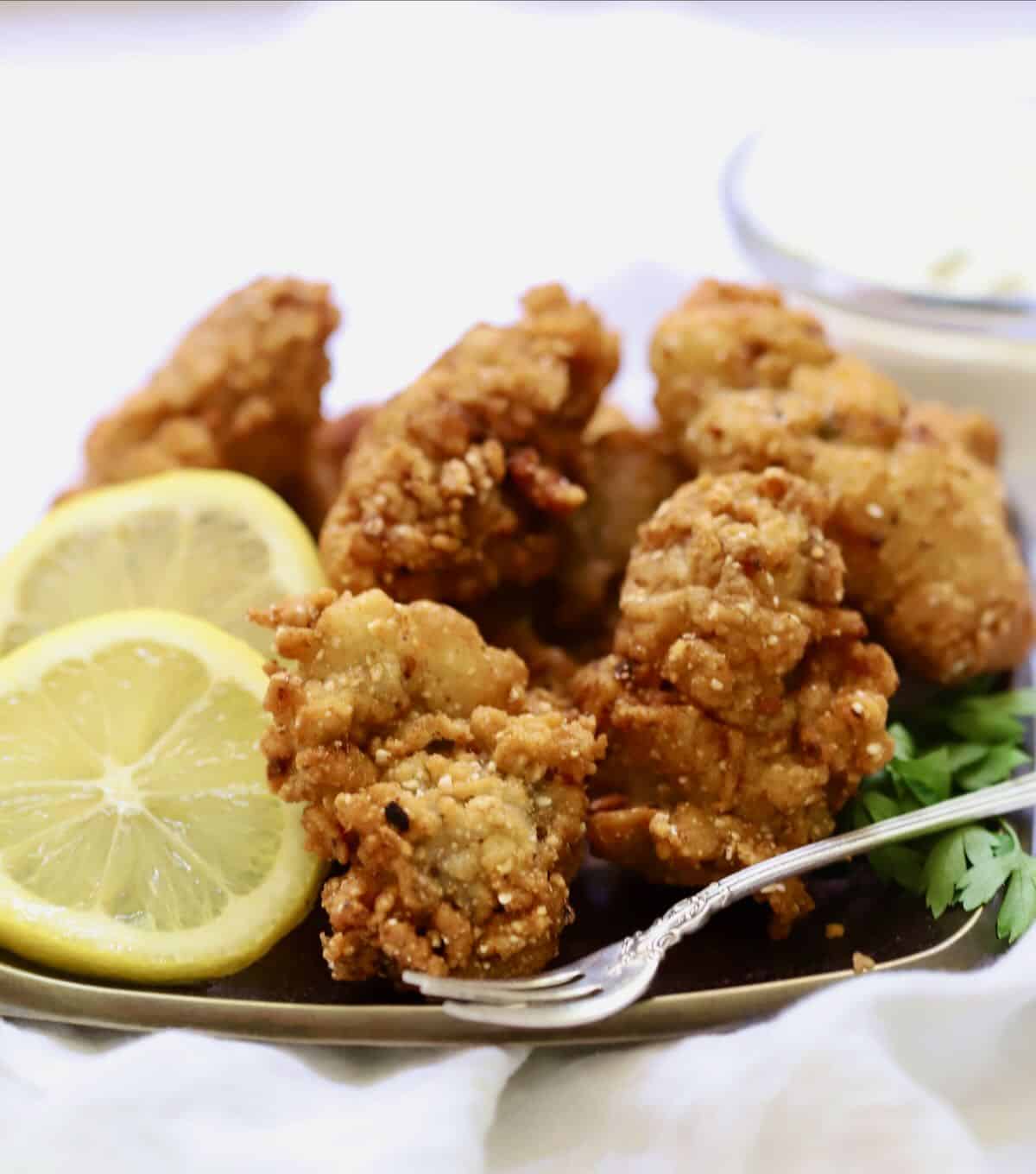
- Optional: garnish with fresh lemon wedges and serve with a dipping sauce of your choice, including tartar sauce, cocktail sauce, or remoulade.
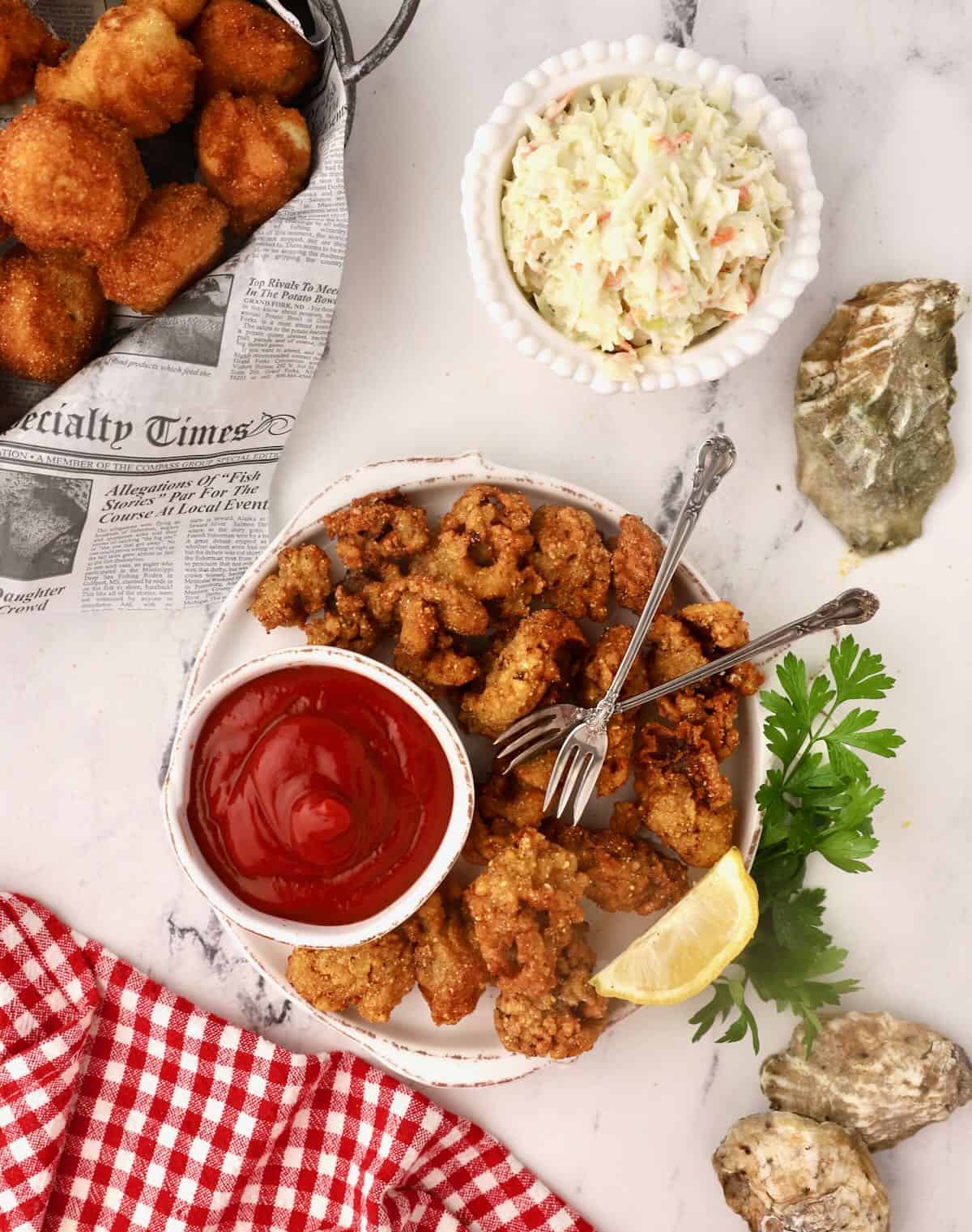
🍲 What do fried oysters taste like?
A fried oyster with a cornmeal crust tastes like sea spray from a crashing wave mixed with an explosion of briny, buttery freshness and delightful crunchiness.
Oysters develop their shape, texture, and flavor (merrior) from the waters where they live. Gulf oysters harvested in the nutrient-rich waters along the Gulf Coast of Florida or Louisiana have a slightly different taste from those harvested in Chesapeake Bay, along the east coast of Maryland, North Carolina, or the Pacific Coast.
All varieties, whether wild or farmed will have a silky, meaty texture and a salty-sweet creaminess.
💭 Top tip:
To minimize grease splatter, use a large heavy-duty stock pot or dutch oven with high sides instead of a cast iron skillet. It will make clean-up easier. And, if you have a screen grease splatter guard to cover the pot, that works even better.
📖 Fried Oyster Recipe Variations:
While I recommend you make this recipe as written, if you prefer, you can vary or adjust it to your family’s preferences.
- Instead of the Creole seasoning, you could substitute Cajun seasoning or Old Bay seasoning.
- You can also make crispy fried oysters without cornmeal by substituting panko, breadcrumbs, or cracker crumbs. In addition, you can use flour only.
- To give them a spicy kick, add a tablespoon or hot sauce to the buttermilk before soaking them. This recipe can also be made without buttermilk by replacing it with an egg wash.
- I prefer cornmeal-breaded fried oysters, but some oyster enthusiasts like using a tempura-style batter containing flour, cornstarch, beer, soda, or water.
🍽 Where to buy fresh oysters:
Depending on where you live, most seafood markets and larger grocery stores such as Publix sell fresh oysters in the shell and shucked. You can also find farmed oysters at farmers’ markets and other venues.
If you are in the Tallahassee area, you can purchase them at Southern Seafood Market or directly from my friend Keller, aka Oyster Mom, who has an oyster farm in Oyster Bay, south of Tallahassee.
🍽Fried Oyster Serving Suggestions
Although fried oysters pair well with most side dishes, they are most often served with either cheese grits, french fries, or fried potatoes with onions, coleslaw, and hush puppies, or hoe cakes.
While I like mine plain, many folks like to serve them with either homemade or purchased tartar sauce, remoulade sauce, ketchup, or a seafood cocktail sauce on the side. I have also seen them served with barbecue sauce, melted butter with lemon, and even buffalo sauce.
How to Store and Reheat Fried Oysters
Fried oysters are best eaten while they are still hot, right after they have been fried.
If you do have leftovers, you can store them covered in the refrigerator for up to three days. I do not recommend freezing them.
They can be reheated on a wire rack in a 350°F oven for about five minutes or in an air fryer set at 400°F for about three minutes.
💬 Recipe FAQs:
If they are freshly shucked, they should be stored covered in the coldest part of your refrigerator where they will keep for up to five days from your purchase date.
Live oysters still in the shell should be stored in a mesh bag and covered with a damp cloth. Stored properly, and freshly harvested, they will keep for up to two weeks in the coldest part of your refrigerator. However, they are best eaten within seven days after they have been harvested.
In years past, they were only harvested and considered safe to eat in the colder months or months with an “r” in them.
With modern refrigeration and the cultivation of farm-raised oysters, they are considered safe to eat and available for purchase twelve months of the year. Wild oysters are generally harvested in the cooler fall months.
Generally, most raw oysters are sold shucked and packaged in pint-size containers. Pints average from sixteen to twenty raw, oysters depending on their size.
The number of servings from a pint depends on who will eat them and their appetite. Usually, a pint will feed two adults when you serve them as a dinner entrée. As an appetizer, a pint will usually feed four adults.
The minimum safe internal temperature is 145 °F, as measured by an instant-read meat thermometer.
The main difference is the amount of oil and the type of pan used. Pan-frying typically involves a shallow cast-iron skillet and around one inch of oil. On the other hand, deep frying is usually done in a deep fryer or Dutch oven with high sides with two to three inches of oil.
You can use either method with this recipe.
To keep the cornmeal breading from falling off when they are fried, after marinating in buttermilk, put the breaded oysters on a metal cooling rack until they all have been coated. Then, let them sit for a few minutes before frying so the buttermilk will act like glue and fuse with the breading.
I always use peanut oil for frying because It has a high smoke point and a neutral flavor. A smoke point is a temperature at which the oil starts to smoke and break down. Other oils with a high smoke point and neutral flavor include canola, sunflower, soybean, and safflower.
💭 More expert tips and tricks:
- To minimize the odor of fried seafood, boil equal amounts of vinegar and water for about ten minutes after frying.
- Shucking oysters or removing their shell requires a special oyster knife and a certain amount of skill. If you are interested in learning how to shuck them, check out this video by America’s Test Kitchen.
- Canned oysters, which can be purchased either fresh or smoked, are already cooked. They are not suitable for use in this recipe.
- Try to maintain a consistent temperature when frying. Too low, and your food will be greasy and soggy. If it’s too high, the crust will burn before it is cooked through.
- To keep your fried oysters warm while the rest cook, place them on a metal rack set over a cookie sheet in a 200 °F oven.
- If you don’t have buttermilk, you can make your own by combining two tablespoons of white vinegar or lemon juice with two cups of whole milk. Let it sit for about five minutes, and voila, buttermilk.
Other Fried Seafood Recipes
⭐ ⭐ ⭐⭐⭐ If you make this dish, please leave a comment and give this recipe a star rating. I would love to know how you liked it!
Thank you so much for visiting Grits and Pinecones; I hope you come back soon!
📋 Recipe:
Want to Save This Recipe?
Enter your email & I’ll send it to your inbox. Plus, get great new recipes from me every week!
By submitting this form, you consent to receive emails from Grits and Pinecones.
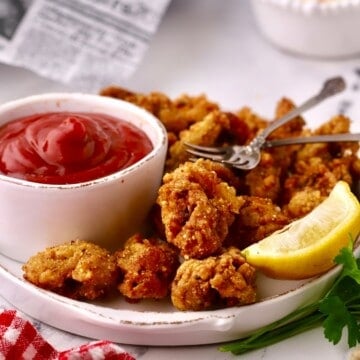
Southern Crispy Fried Oysters Recipe
Equipment
- Large stock pot, Dutch oven, or cast iron skillet with high sides
- A screen grease splatter guard is optional but will minimize the oil splatter
- Kitchen metal spider, or large slotted spoon
- Deep fry or candy thermometer
- wire cooling rack
Ingredients
- 1 pint freshly shucked raw oysters
- 2 cups buttermilk
- 1¼ cup fine yellow cornmeal
- ¾ cup all-purpose flour
- 1 tablespoon Creole seasoning
- 1 teaspoon kosher salt
- 1 quart peanut oil
Instructions
- While the oil heats, pour the oysters into a colander or strainer and let them drain. Then, rinse with fresh water to wash off any debris or shell fragments.
- Pour the buttermilk into a medium-sized bowl and dunk the drained oysters. Let them marinate for 15 to 20 minutes.
- Place the cornmeal, flour, creole seasoning, and salt in a shallow bowl or pie plate and whisk to combine.
- Remove the oysters from the buttermilk one at a time and dredge them in the cornmeal mixture. Toss gently and make sure they are well coated, then shake any excess breading off.
- Place the coated oysters on a metal cooling rack until all of them have been coated. Letting them sit for a few minutes helps to fuse the breading and buttermilk and keeps the breading from falling off when they are fried.
- Place a large stockpot, Dutch oven, or cast iron skillet with high sides over medium-high heat and add one to two inches of oil.
- When the oil reaches 350 °F, carefully add the oysters to fry one at a time. Depending on the size of your pan, it works best to fry in batches and only cook six to eight at a time. You do not want to crowd them. (Maintain a consistent heat of 350 °F by increasing or decreasing the heat under the pan.)
- Let the oysters fry for about two to three minutes, stirring occasionally or until the breading is light golden brown and the meat is opaque with the edges slightly curled. Use a wire kitchen spider or slotted spoon to remove them from the oil. Place on a paper towel or wire cooling rack to drain.
- Repeat until all of the oysters are fried and serve immediately. Optional, garnish with fresh lemon or lime slices and serve with your choice of sauce and sides.

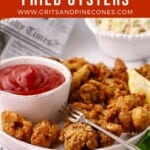
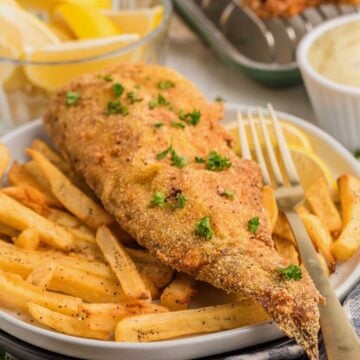
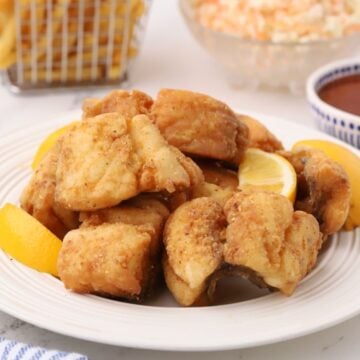
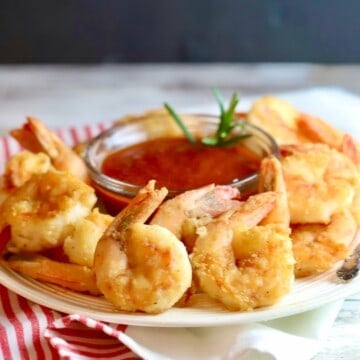
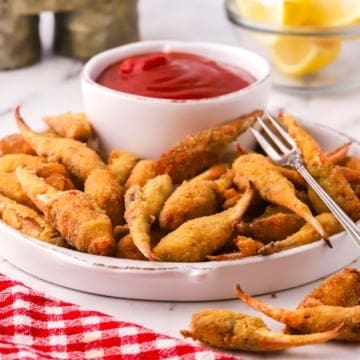
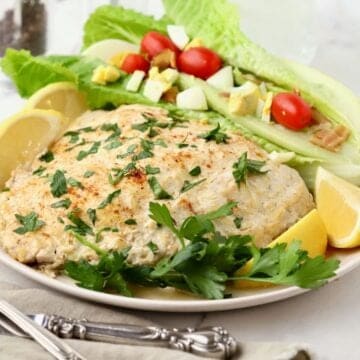

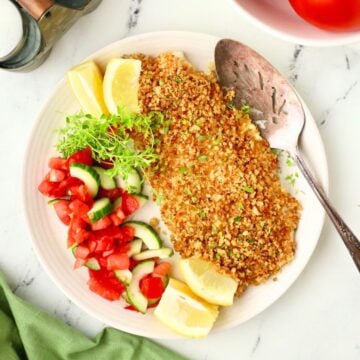
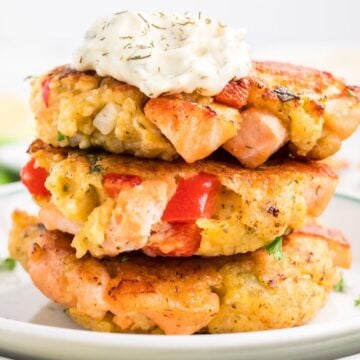

Amy
I was nervous about frying oysters, but this recipe was simple and delicious. Oysters were great with a golden crunchy coating!
I thought there was going to be too much of the flour and cornmeal mix for a pint of oysters. I did throw some away, but I used it all because it gums up a bit as you coat the oysters. So don’t half the dry ingredients as I considered doing!
LaVonne
Fabulous recipe! I did take your hints and added hot sauce to the buttermilk, as well as additional hot seasoning to the breading. It was not too hot at all! Next time I will get more aggressive with the seasonings!
Also, thank you for the tips on making my own buttermilk, as well as getting rid of the smell with equal parts vinegar. I did not know that would help with the odors after!!!
Jade
I don’t often comment on recipes but this was absolutely perfect. I had powdered buttermilk and whole milk which when mixed did the job just fine.
Debbie
I followed the recipe exactly and the oysters were most delicious
I will definitely make them again
Sharon Rigsby
Awesome! I’m so glad you liked them!
All the best,
Sharon
Jana
This coating was just perfect for perfect oysters! Yum yum. However, the one correction I would suggest is . . . never, I mean NEVER, drain ANY fried food on a paper towel. Use a wire basket with a paper towel-lined tray underneath. Drains and doesn’t hold the grease on the food. Try it – you’ll like it!
Ken Massie
This is the best oyster recipe I have tried! Follow the very simple recipe and you will not be disappointed.
Ray Kirby
We did this today and it was perfect. We had a little different ratio but did the easy math and they came out perfect. Thanks to the “supply chain issues” we couldn’t find yellow corn meal (seriously in Charlotte NC and several stores and no yellow corn meal). So, we used white corn meal and it still worked out great. Thanks.
Carolyn
Made these last night and they were absolutely perfect, light and crisp on the outside lucious and soft oysters on the inside. These will be a favorite in our household now. Used them in tacos, but they would be also perfect as an appetizer or meal. Just YUM!
Syd
Difficult to regulate heat. I got the oil to 375, but when I dropped the oysters in the temp went right to 400 and first batch burned. Then oil dropped quickly and other batches cooked fine at 300. Any tips?
Sharon Rigsby
Hi Syd,
I’m sorry you had problems regulating the oil heat. I wish I had a magic answer to solve your issues; however, the burners on every stove are different, and there are also differences in electric, gas, induction, and glass top burners. I have both glass top and induction, and since the glass top burners are very slow to respond, I sometimes have to completely remove my pan to another burner to slow things down. On the other hand, the induction burners change temperatures very quickly when adjusted up or down. The only tip I can give is to know your stove, continue using a thermometer, and note how an adjustment to your burner affects the temperature. The other thought I had was maybe the heat was on too high when you added your first batch of oysters. If anything, the oil temperature should have gone down, not up! Maybe next time, try keeping the oil at a consistent temperature by turning the heat up or down for a few minutes before adding any food. I do hope you enjoyed the oysters, and good luck!
Sharon
Judy
Made them for Christmas Eve! Perfect!! I used Ole Bay seasoning. I’m from the Mississippi Gulf Coast and the recipe compares very favorably!
Chute Adams
Really great, followed recipe exactly, except used fry pan so i could set temp at 375. Peanut oil came in 1.5 pint container, i just used that. Had to search a little for creole seasoning, but I found some. Cajun seasoning was everywhere, but I held out for creole. Was absolutely great. Dont overcook, go with small batches.
Leilani
Can you freeze these and bake them later?
Sharon Rigsby
No, I’m sorry, but you can not freeze fried oysters. It will change the texture of the oysters and the coating will be soggy.
BTekin
Thanks for the recipe. Being Christmas I got a craving for oysters. My dad made the best oyster stew (milk based broth) on Christmas morning. I prefer good fried ones. I did modify yours. Instead of flour I used use 1 cup of plain panko bread crumbs and increased the yellow cornmeal. I only had Old Bay seafood seasoning and Canola oil for frying. OMG, they turned out awesome, about the best I’ve ever had.
Deborah Faircloth
I made tonight. It was such an easy recipe. However I used seafood batter mix instead of corn meal and flour. Very delicious
Francine
Hi Sharon,
I am glad to have found this recipe, I am going to try it tomorrow as soon as I have bought the fine cornmeal and the buttermilk. I have a question: do you rinse the bottled oysters before draining them?
Sharon Rigsby
I do not rinse the oysters first. I hope you enjoy this recipe!
Papajoe911
Great, did it Father’s Day
Debi
Made this today, a perfect recipe. The cornmeal made it crispy & crunchy.